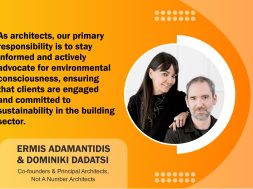Thessaloniki Byzantine legacy inspires new autograph collection hotel design

This discussion delves into integrating sustainability and environmental awareness within architectural projects while tackling the challenges of climate change and evolving landscapes.
Can you share insights into one of your best projects, highlighting the design elements that set it apart?
One of our recently completed projects, which has been widely recognised, is Monasty Hotel. The project’s design draws inspiration from the thousand-year Byzantine heritage of Thessaloniki, which remains faintly evident in the numerous Christian orthodox temples of that era still standing in the city’s historic centre. The spirituality of those spaces is the magic that we tried to instill in the design of the new Autograph Collection hotel and simultaneously merge an alternative sense of locality with the international luxury brand of Marriott. What sets it apart is the mystic atmosphere achieved throughout the interior spaces of the 100-room hotel, with an austere materiality and subtle use of natural and artificial lighting. The monastic experience is coupled with the high-end operation of a 5-star hotel, making it a luxury refuge from the bustling city centre.

How do you incorporate efficiency principles into your architectural designs, especially regarding space utilisation and energy efficiency?
We are a concept-driven practice, and we believe in the efficiency of a good design concept. Whether we have to design a new building or remodel an existing one, we spend most of our energy developing a design strategy that will positively resonate on many levels over time. A holistic approach from the beginning of a design problem is fundamental, and the glue that binds all the different factors, such as structure, materiality, climate, landscape, and context, is a well-structured architectural concept.
How do you ensure sustainability and environmental consciousness in your architectural projects, especially considering diverse climates and landscapes?
The client’s commitment towards this goal is the major challenge regarding sustainability in the building sector. What we should do as architects is always be informed and, in turn, pass the environmental consciousness on to the client. The path is only sometimes straightforward, and that is where the architectural concept plays its role again. We develop a concept incorporating sustainability as an added value for the client. That includes initial research into the local conditions, whether the climate, material resources or social patterns will help us root the project more efficiently in its habitat.

How do you approach modular construction in modern architecture, and what strategies do you employ to balance innovation and functionality?
We have realised projects with modular construction in the small scale of installations and pavilions such as Bulgari Pavilion, Bulgari Pop-up Shop and Core Agora. Innovation was pursued through material experimentation. We tested the material properties to the extent that we could create novel spatial and environmental qualities. With the Bulgari pavilion, the first ever self-standing vaulted structure was created entirely from acrylic tubes. We twisted solid surfaces in a double-curved fluid structure in the pop-up shop. We used wood as a modular facade system in the Core Agora project. Thin plywood ribbons are used like a soft material knitted around the pavilions, creating a protective skin.
How do you perceive Indian architecture, and have you drawn inspiration from any specific elements in your international projects?
I guess it is the expressionistic qualities of Indian architecture that make it unique in the world. Good Indian practice also gives great building examples in using natural materials, which we usually try to learn from. We loved studying Studio Mumbai’s work during our first steps as a young office.
For more information, visit: https://nan-a.eu/
28
Cookie Consent
We use cookies to personalize your experience. By continuing to visit this website you agree to our Terms & Conditions, Privacy Policy and Cookie Policy.







